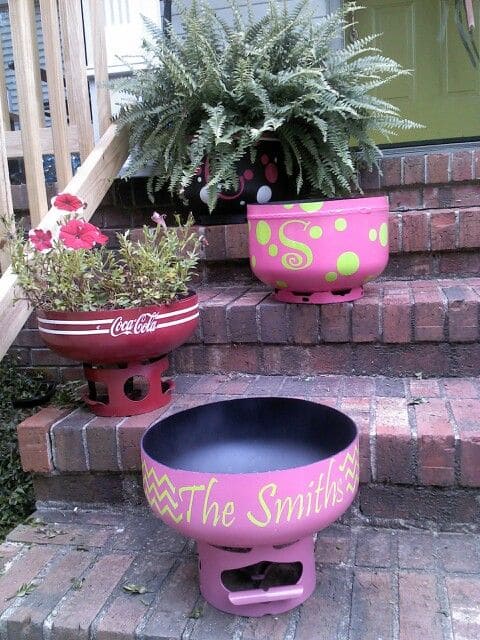
You can see these planters, cut from old propane tanks, are transformed with bold colors and personalized designs.
A simple coat of paint turns them into conversation starters, and you can tailor the style to match your home like retro stripes, whimsical dots, or elegant monograms.
They’re sturdy enough to hold large plants and stylish enough to rival store-bought décor. This project proves you don’t need expensive pots to create a porch or patio that feels welcoming and unique.
Materials Needed
- 1 empty propane tank (standard 20 lb, about 12″ diameter)
- Angle grinder with cutting disc
- Metal file or sandpaper (80-120 grit) to smooth edges
- Protective gear: gloves, goggles, and mask
- Rust-resistant primer (spray, 250ml)
- Acrylic outdoor spray paint (2-3 colors, 250ml each)
- Stencils or painter’s tape
- Paint markers (optional)
- Clear outdoor sealer
- Potting soil and your choice of plants
Step-by-step Guide
Step 1: Make sure your propane tank is completely empty and clean. Then remove the valve and allow it to sit outside for a few days to release any lingering gas.
Step 2: Using your angle grinder, cut the top section off the tank to create an open planter bowl. You can smooth the edges carefully with a file so they’re safe to handle.
Step 3: Apply a coat of rust-resistant primer over the entire surface. Let it dry fully, this step is key to keeping your planters looking fresh outdoors.
Step 4: Spray-paint the base color (like pink, red, or green). Once it’s dry, add patterns with stencils, tape, or freehand designs. This is where you can personalize with names, initials, or fun motifs.
Step 5: Seal the paint with a clear outdoor varnish to protect against rain and sun.
Step 6: Fill with soil and add your favorite plants, from colorful flowers to hardy ferns. Place them on steps, patios, or in garden corners for a pop of personality.
Tips: When painting, go for lighter colors under darker ones as it helps designs stand out crisply.
If you’re planning to keep these outdoors year-round, add a few drainage holes at the bottom before planting, so roots don’t sit in water.
